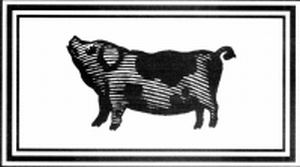Pork ciste.
Ciste can mean either cake or coffin in Gaelic; on this page it runs to the funereal and refers to the Irish practice of entombing pie filling in a basin or pot covered with suet pastry. It is a genuine if modest Irish innovation. The basin stays unlined, so the ciste is a more expeditious route than either pudding or pie. The pastry itself is a little unusual in using milk instead of water and incorporating the raisins that complement the pork. It is, as Theodora Fitzgibbon knew, an “excellent winter meal… Traditional Irish dish, nowadays found only in Irish homes.” ( A Taste of Ireland , London 1968, 65) For four; may be halved, increased to six or doubled. The proportions remain constant.
 For the filling:
For the filling:
- 4 pork chops on the bone
- 4 lamb kidneys, ½ a veal kidney or 2 pork kidneys (all optional; see the notes) cut into 1 inch chunks
- salt and pepper
- about ½ cup chopped celery
- about 1 ½ cups onions, peeled and sliced into thin crescents
- a bay leaf
- heaped Tablespoon minced parsley
- about ½ teaspoon rubbed sage
- about 1 ½ cups pork or vegetable stock
- Worcestershire
For the pastry:
- 1 ½ cups self-raising flour ( see the notes)
- 3 oz (or about 2/3 cup) grated suet
- 1/3 cup raisins
- dash of white pepper
- heaped ¼ teaspoon salt
- 1/3 to ½ cup milk, depending
Preheat the oven to 325°.
- Season the chops with generous doses of salt and pepper, then line the sides of a pudding basin or ovenproof pot of appropriate size with them; the bones will stick up past the rim of the vessel.
- Season the kidney and toss it with the celery, onions and herbs, then put the mixture inside the chops.
- Add a sprinkle of Worcestershire, then pour enough stock into the well just to cover the kidney mixture, cover the basin or pot and bake it for half an hour.
- Make the pastry: Mix together the flour, suet, raisins, white pepper and salt, then gradually add just enough milk to form the pastry into a cohesive ball.
- Roll the pastry out (or use the heel of your hand to spread it) on a floured board to the circumference of your basin or pot.
- Once the filling has spent that 30 minutes in the oven, lay the pastry atop the filling, punching through the chop bones as needed.
- Pleat and butter a sheet of foil and crimp it onto the ciste, again accommodating the bones as necessary.
- Bake the ciste for another hour.
- Serve the ciste by quartering the pastry and setting a chop and a quarter of the filling alongside each wedge of the pastry.
Notes:
- While we have labeled the kidney optional for the sake of the sqeamish, in reality we consider them essential. If you do not like the idea (you will have no problem with the fabulous flavor the give the ciste), then substitute some liver. If offal offends you, use a few chunks of ham as a last resort. But things will never be the same.
- Pork kidneys would be optimal but they are difficult to find in the United States. Chinese markets, however, do tend to carry them and they freeze well.
- If you do not have any self-raising flour, substitute plain flour and add a teaspoon of baking powder at Step 4.
- Theodora FitzGibbon uses carrots, not celery. We are of two minds about the sweetness they bring to the dish in conjunction with the raisins in the pastry, which add a lovely layer of flavor and complement the pork.
- As a first choice she also cooks her ciste at a simmer on the stovetop, while allowing that the oven is an option. We like the greater control that the even oven temperature provides.
- FitzGibbon also substitutes about double the amount of fresh thyme for our sage. It is equally good, although we prefer the same amount of dried as we specify for sage.
- FitzGibbon suggests lamb chops as an alternative to the pork, but that is an expensive proposition we are unwilling to accept in these straitened times. If you feel flush and use lamb, skip the raisins as she also suggests.
- Except when it comes to Dublin coddle, we prefer not to cook with water instead of stock, but it is a viable option here.
- FitzGibbon uses no Worcestershire.

